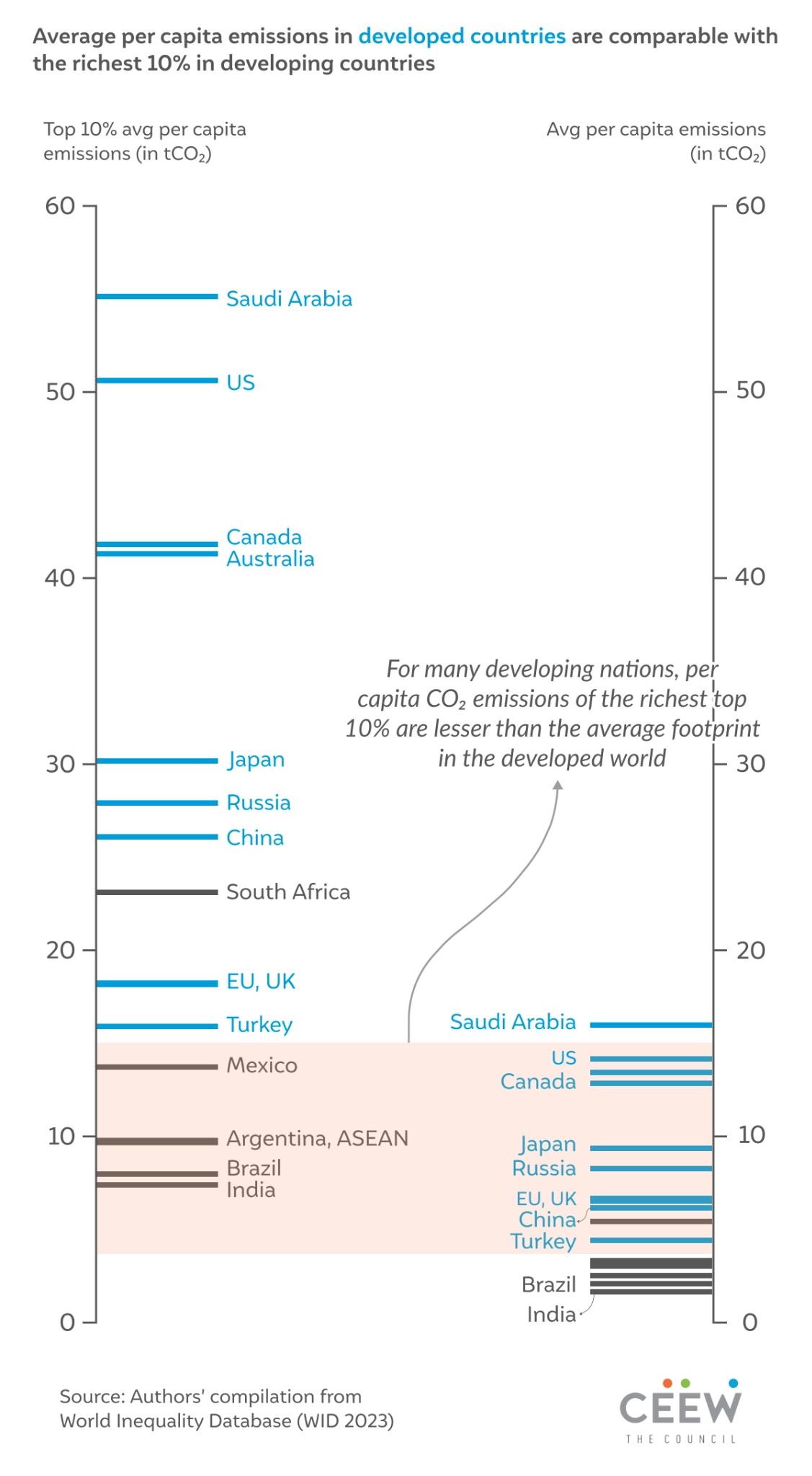



– Richest 10% in developed nations, China adopting low-carbon lifestyles could save 3.4 billion tonnes of CO2 yearly
– A carbon tax on the richest 10% in developed countries and China could generate USD 500 billion for climate change mitigation
New Delhi, 28 November 2023: The carbon dioxide emissions of an average earner in many developed countries are much higher than the emissions of the richest 10 per cent in developing countries such as Argentina, Brazil, India and the ASEAN region, according to a new independent study released by the Council on Energy, Environment and Water (CEEW) today. The emissions divide between developed and developing countries is starker when we compare the poorest populations. The carbon emissions of an individual in the bottom 10 per cent income bracket of Saudi Arabia, the US, or Australia are 6 to 15 times more than an individual in the poorest decile of India, Brazil or the ASEAN region. As world leaders gather at the 28th Conference of Parties (COP28) in Dubai for a Global Stocktake, the CEEW study underscores the urgent need for developed countries and China to embrace sustainable lifestyles and vacate carbon space for developing countries.
The CEEW study—using data from the World Inequality Database and the World Bank—analysed per capita CO2 emissions for different income brackets across 14 countries, EU and the ASEAN region spanning the developed and developing world. These major economies, taken together, represent approximately 81 per cent of global emissions, 86 per cent of the world’s GDP, and 66 per cent of the global population. Among the countries considered for the analysis, the study, The Emissions Divide: Inequity Across Countries and Income Classes, found that the richest 10 per cent in the developed countries and China emitted 22 per cent more CO2 than the total emissions of all the developing countries studied.
Dr Arunabha Ghosh, CEO, CEEW, said, “The CEEW study clearly shows that not everyone is equally responsible for increasing global carbon emissions. The top 10 per cent in many developing countries emit less than the average per capita emissions in developed countries. This, once again, drives home the scientific basis for ‘common but differentiated responsibilities’, especially as COP28 holds up a mirror to past pledges and broken promises. The findings make the need for accountability and long-term climate finance both imperative and immediate. We can no longer argue why emerging economies need carbon space, or cheap and convenient finance to power their sustainable futures. Moreover, there is no technological substitute for more conscious consumption. Developed countries must make sustainable consumption aspirational, just like India’s Mission LiFE, which nudges individual action to catalyse global changes for people, prosperity and the planet.”

The CEEW study also found that encouraging the adoption of low-carbon lifestyles among the richest can lead to significant emission reductions. If the richest 10 per cent of developed countries and China reduce their carbon footprint even by half, they can save more than 3.4 billion tonnes of CO2 annually. Moreover, a carbon tax on the richest 10 per cent of developed countries and China could shore up USD 500 billion and discourage highly carbon-intensive consumption patterns, the study found. These funds could be used for climate change mitigation, research and development, de-risking clean technology, and building resilience. This is crucial since another recent CEEW study showed that developed countries are not on track to meet their 2030 emission reduction targets, and will overshoot their Nationally Determined Contributions (NDCs) by 38 per cent.
Pallavi Das, Programme Lead, CEEW, said, “Inequity in the climate debate has a long-standing history and the rich in developed countries are primarily responsible for carbon emissions. Our study shows that while the emission intensity of income has reduced for the highest earners (top 10 per cent) in most countries between 2008 and 2018, overall emissions are increasing because of the rise in incomes. With the carbon budget depleting to keep the world below the 2°C threshold, the rich must be held accountable and nudged to pursue sustainable lifestyles.”
The CEEW study also highlighted that the carbon emissions across both developed and developing countries reveal significant inequities between the wealthiest and poorest income brackets. The difference in the carbon footprint between the top and bottom income 10 per cent ranges between 8 and 22 times for the countries studied. This makes it clear that high earners must make concerted efforts to adopt low-carbon lifestyles and practice responsible consumption.
Sustainable living should include practices such as installing energy-efficient appliances in homes and offices, switching off appliances when not in use, increasing the set temperature in air conditioners for appropriate thermal comfort, and using natural daylight. Furthermore, embracing measures such as the use of public transport and carpooling can significantly decrease emissions related to personal commuting. Emissions that cannot be avoided can be offset through carbon offset programmes. Finally, by shifting to low-carbon products and technologies, individuals can create demand that can incentivise businesses to develop and provide sustainable alternatives, which can then spur a low-carbon economy.
In this study, ‘developed countries (or regions) and China’ include: Australia, Canada, China, European Union, Japan, Russian Federation, Saudi Arabia, Turkey, the United Kingdom, and the United States, and ‘developing countries (or regions)’ include: Argentina, Brazil, India, Mexico, South Africa, and ASEAN.
For media queries contact: Tulshe Agnihotri – [email protected] | +91 9621119643 / +91 7905717812